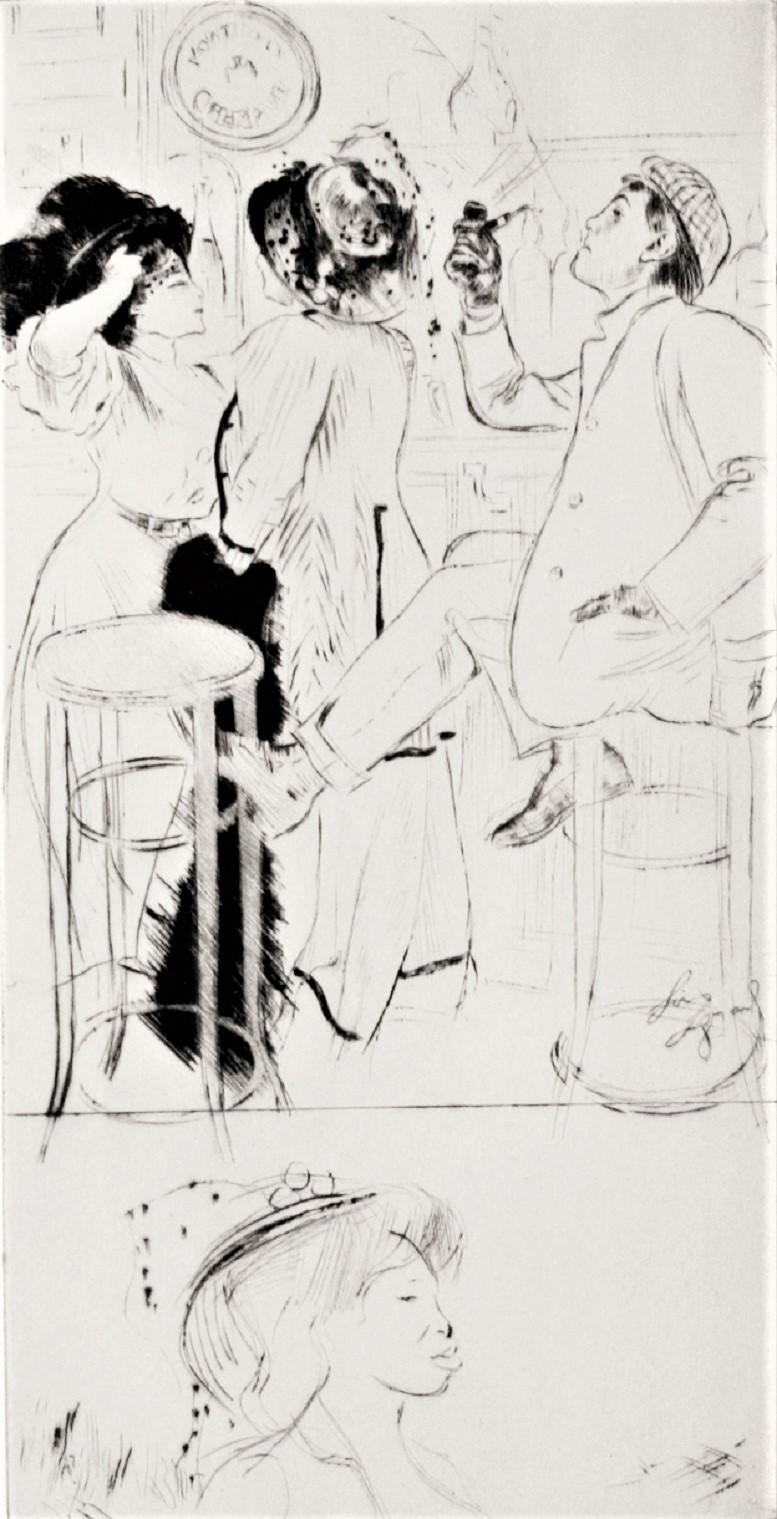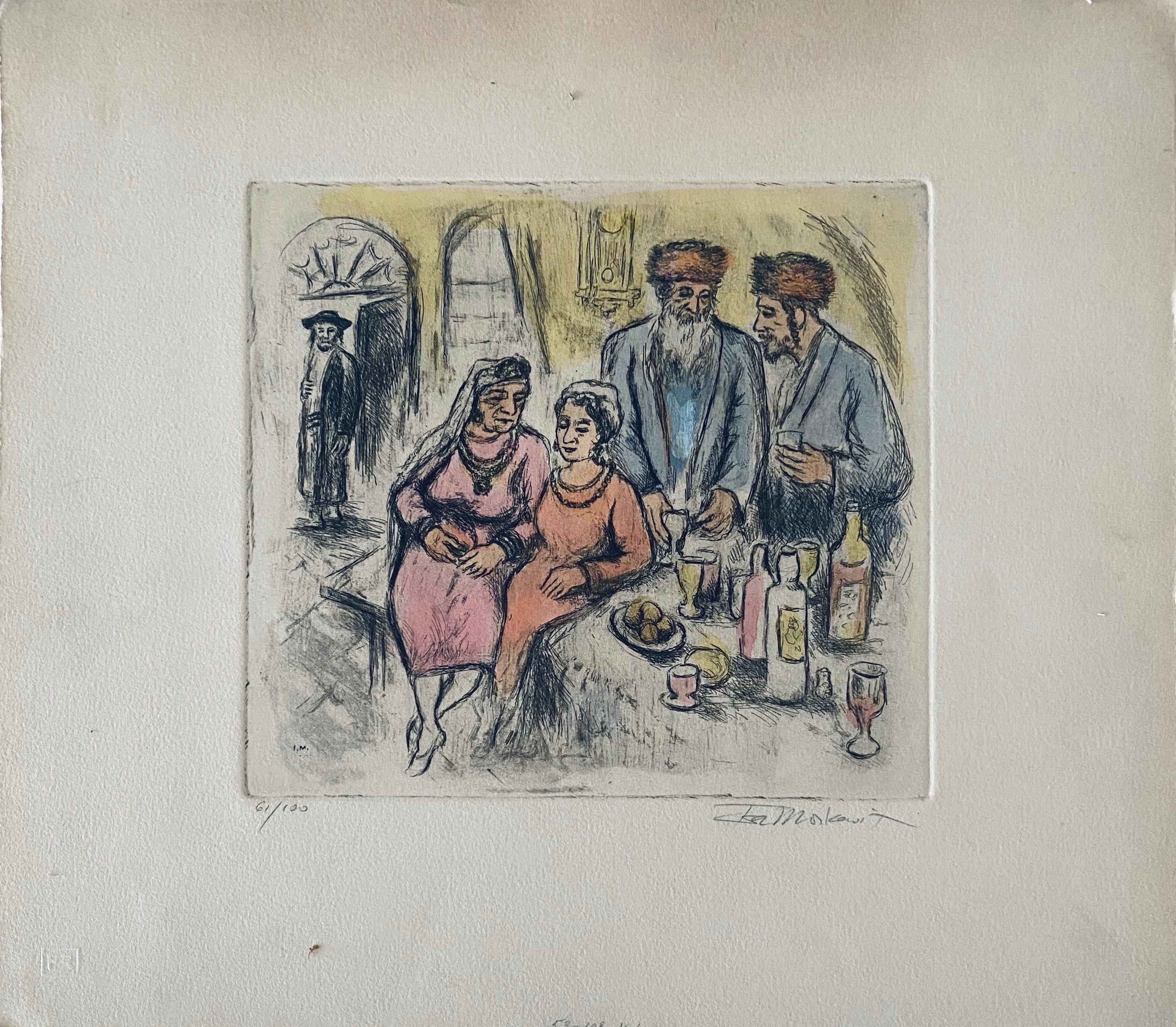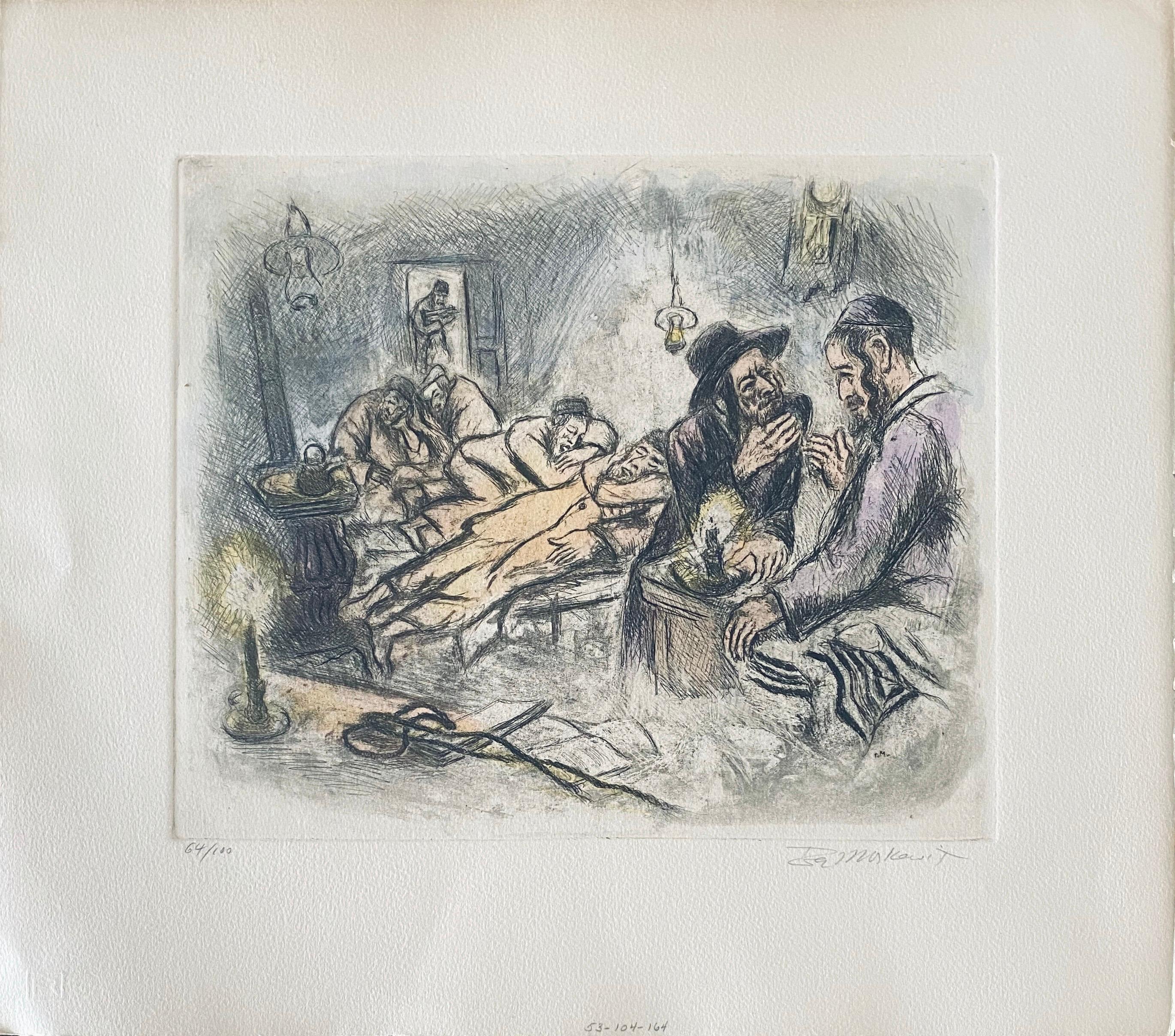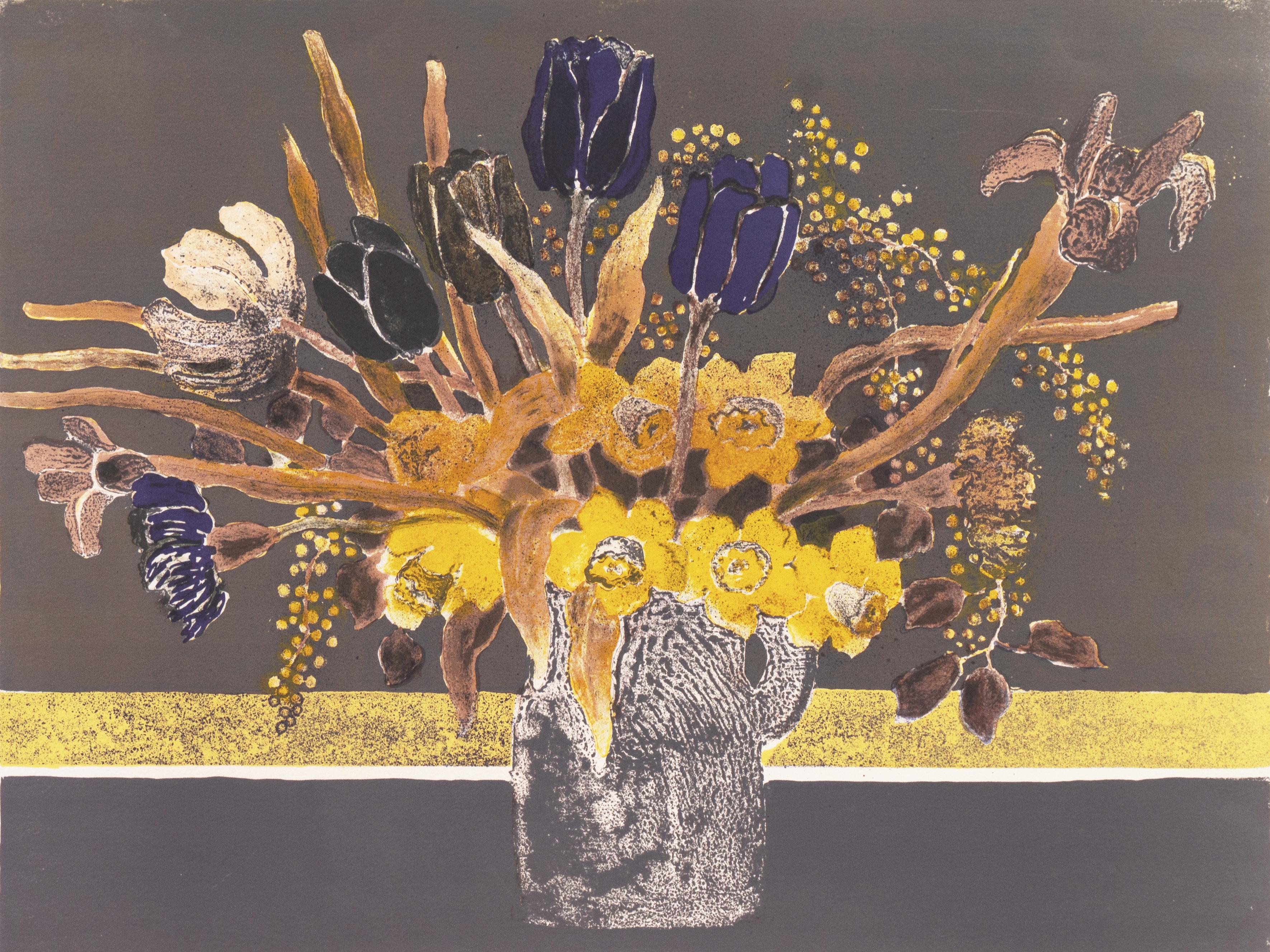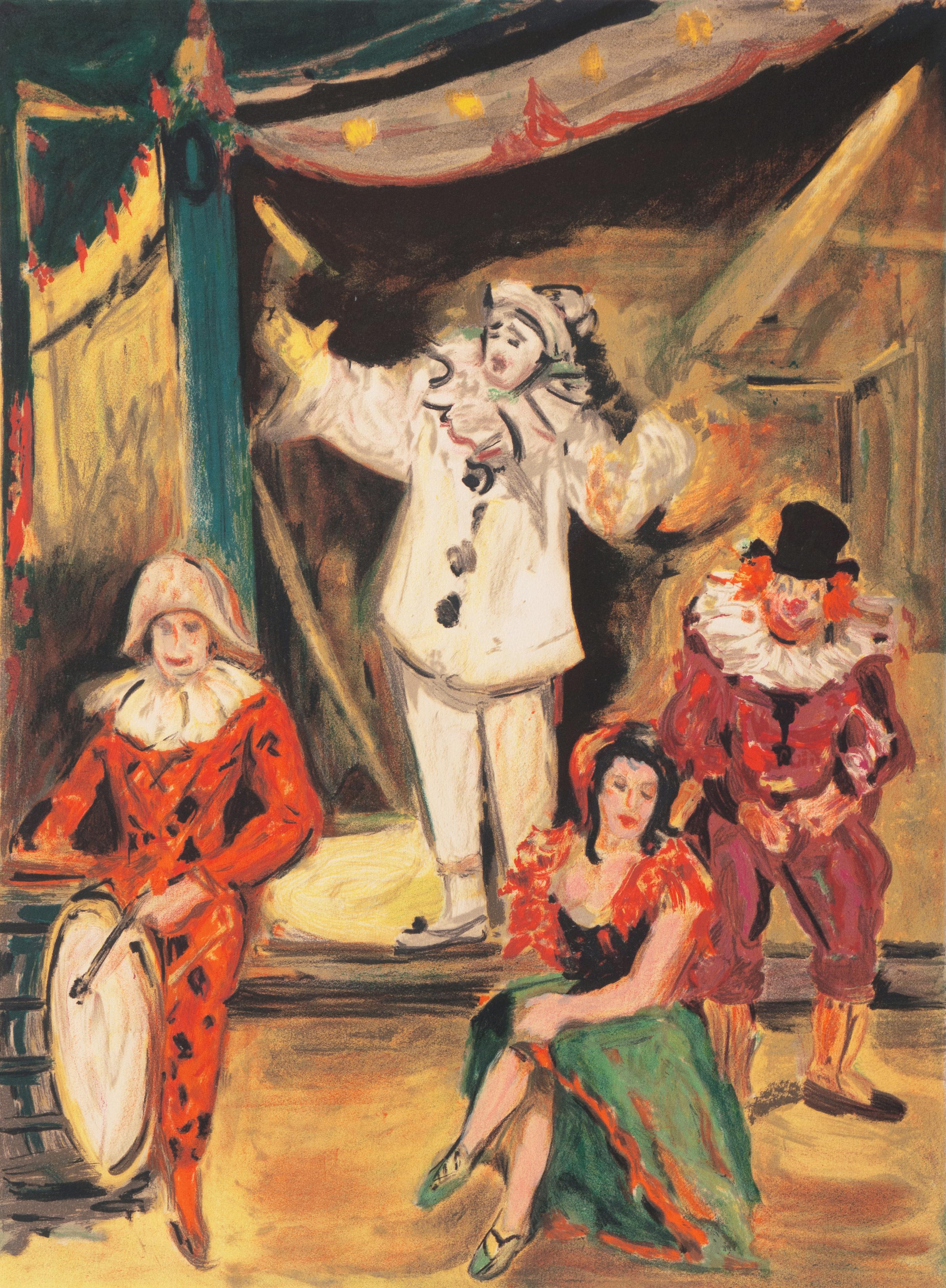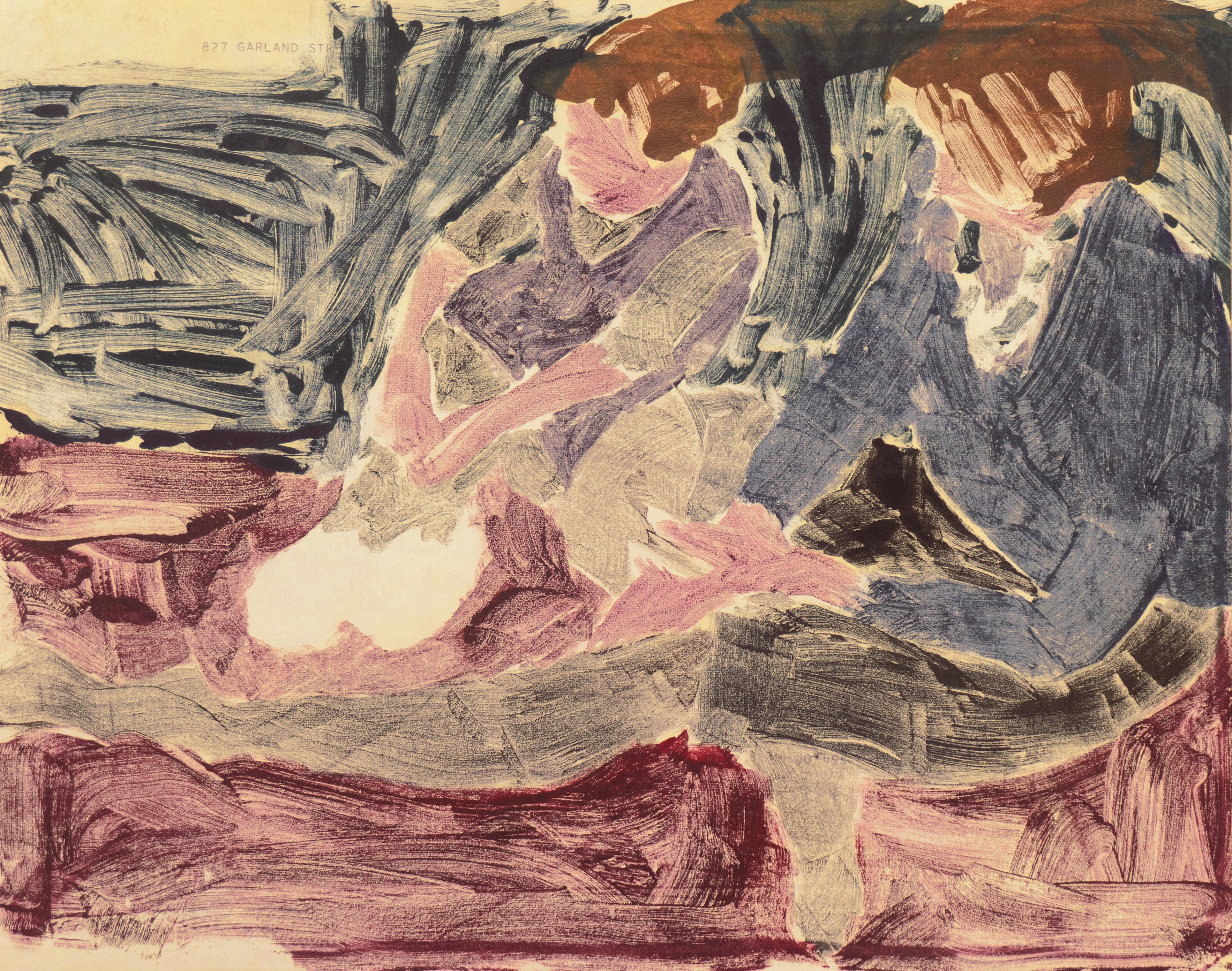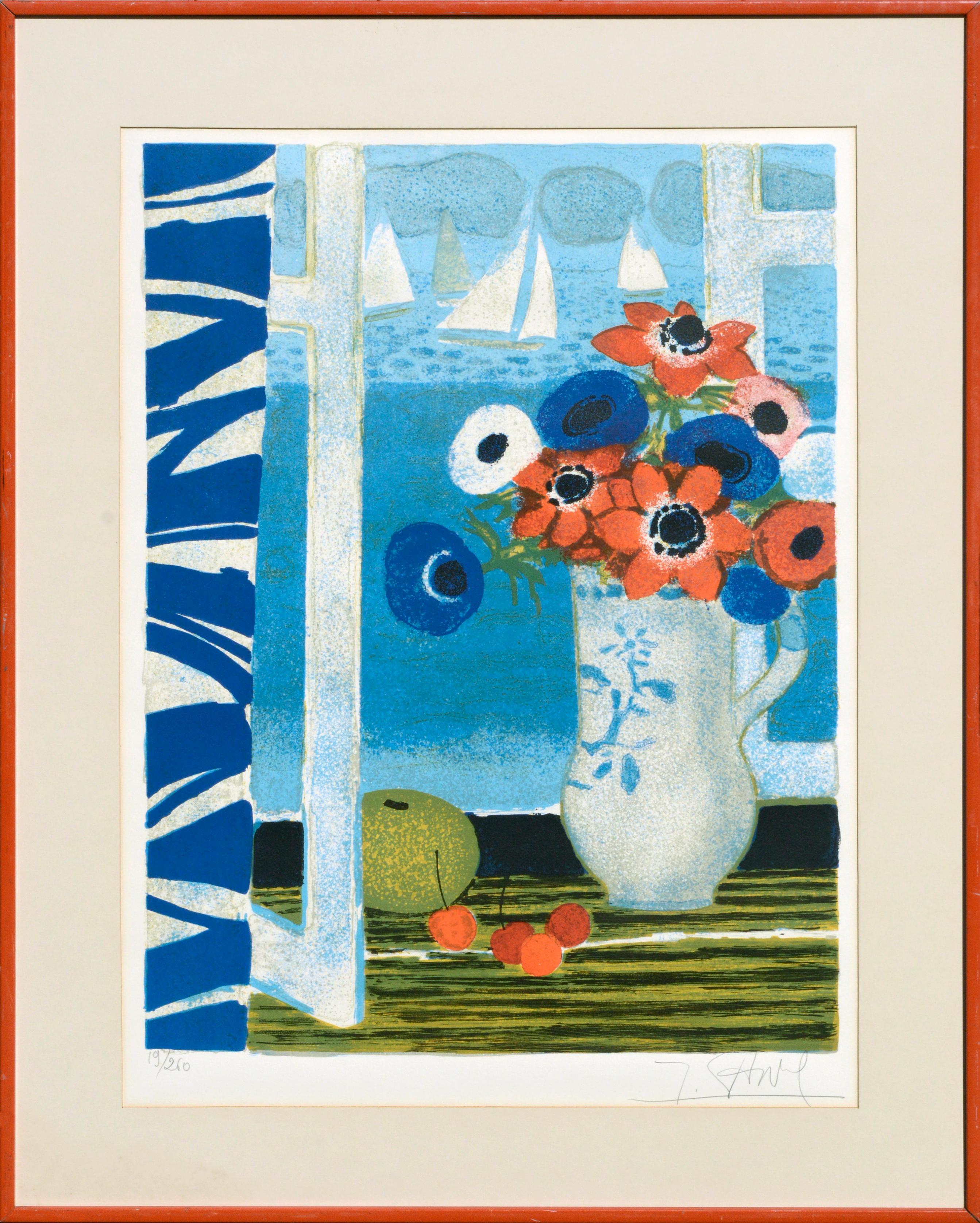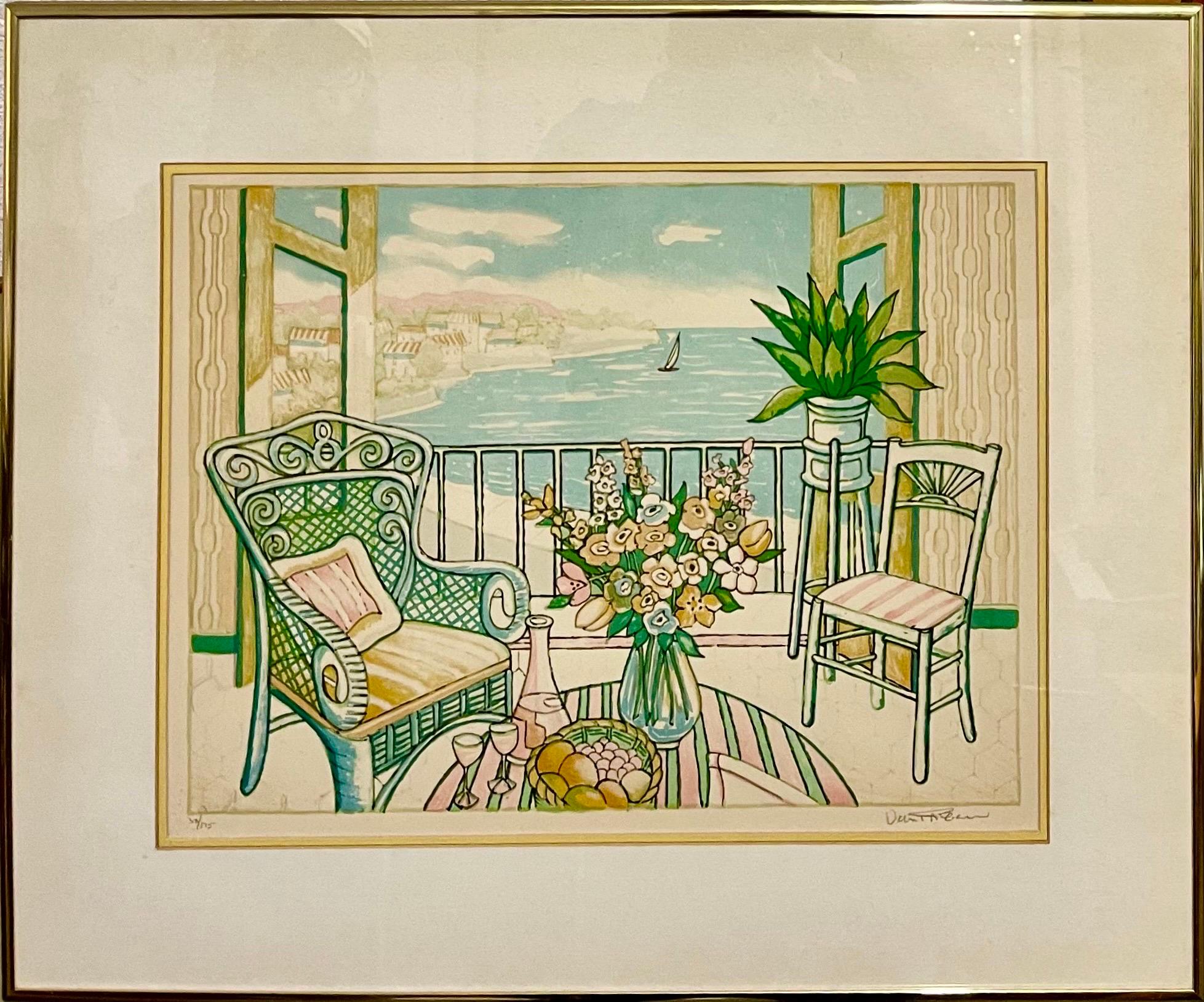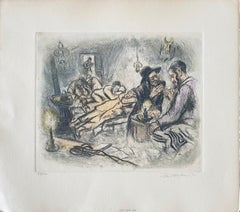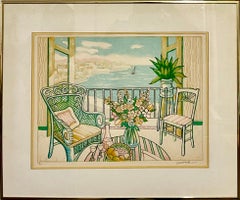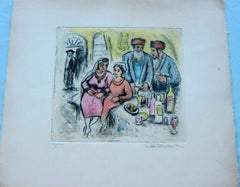
Judaica interior scene etching with hand coloring
View Similar Items
Want more images or videos?
Request additional images or videos from the seller
1 of 8
Ira MoskowitzJudaica interior scene etching with hand coloring
About the Item
- Creator:Ira Moskowitz (1912, American)
- Dimensions:Height: 15 in (38.1 cm)Width: 17 in (43.18 cm)
- Movement & Style:
- Period:
- Condition:
- Gallery Location:Surfside, FL
- Reference Number:1stDibs: LU382116558
About the Seller
4.9
Platinum Seller
These expertly vetted sellers are 1stDibs' most experienced sellers and are rated highest by our customers.
Established in 1995
1stDibs seller since 2014
1,549 sales on 1stDibs
Typical response time: 1 hour
More From This SellerView All
- Judaica interior scene etching with hand coloringBy Ira MoskowitzLocated in Surfside, FLI believe the scene is of a wedding engagement. etching with extensive hand coloring (making it a unique original work of art) Ira Moskowitz (1912-2001), descendant of a long rabbinical line, was born in Galicia Poland and went with his family to Prague, Czechoslovakia, in 1914. The family remained there until 1927, and young Moskowitz received his first education in Prague's schools. Soon after, his family moved to New York City, and in 1927 Moskowitz became the pupil of Henry Wickey at the Art Students League, having finally resolved his conflict between a passion for drawing and a desire to follow the rabbinical profession of his forefathers. Between 1935 and 1938, he traveled to Israel and to Europe, Paris, France where he studied the works of the old masters, an interest derived from his first teacher and one that eventually led to his active collaboration in 1954 on the four-volume series, "Great Drawings of All Time." In 1939, Moskowitz made his first trip to Mexico, and stayed for six months. In 1943 he received a Guggenheim Fellowship and moved to New Mexico, where he remained for seven years drawing the Indians and becoming an active member of the Taos-Sante Fe artists group. It was in New York, as a student of Harry Wickey and Jerome Meyers at the Art Students League ( 1928 -32), that Moskowitz honed his talents as an artist. In the mid-to-late 1930s in Mexico, Ira was drawn to the traditions of the native peoples; in Israel, what was then British MandatePalestine he was absorbed with the religious ceremonies of the Hasidic Jews. The prints and drawings Moskowitz created in Mexico in 1941 earned him a Guggenheim Fellowship in 1943. In 1944, Ira and his wife, the artist Anna Barry moved to Taos, New Mexico. Moskowitz was entranced by New Mexico's light, landscapes, and cultures. By the time Ira arrived there, the region had already attracted Georgia O'Keeffe, Robert Henri, and Leon Gaspard...Category
20th Century Post-Impressionist Interior Prints
MaterialsLithograph
- Judaica interior scene etching with hand coloringBy Ira MoskowitzLocated in Surfside, FLEtching with extensive hand coloring (making it a unique original work of art) Ira Moskowitz (1912-2001), descendant of a long rabbinical line, was born in Galicia Poland and went with his family to Prague, Czechoslovakia, in 1914. The family remained there until 1927, and young Moskowitz received his first education in Prague's schools. Soon after, his family moved to New York City, and in 1927 Moskowitz became the pupil of Henry Wickey at the Art Students League, having finally resolved his conflict between a passion for drawing and a desire to follow the rabbinical profession of his forefathers. Between 1935 and 1938, he traveled to Israel and to Europe, Paris, France where he studied the works of the old masters, an interest derived from his first teacher and one that eventually led to his active collaboration in 1954 on the four-volume series, "Great Drawings of All Time." In 1939, Moskowitz made his first trip to Mexico, and stayed for six months. In 1943 he received a Guggenheim Fellowship and moved to New Mexico, where he remained for seven years drawing the Indians and becoming an active member of the Taos-Sante Fe artists group. It was in New York, as a student of Harry Wickey and Jerome Meyers at the Art Students League ( 1928 -32), that Moskowitz honed his talents as an artist. In the mid-to-late 1930s in Mexico, Ira was drawn to the traditions of the native peoples; in Israel, what was then British MandatePalestine he was absorbed with the religious ceremonies of the Hasidic Jews. The prints and drawings Moskowitz created in Mexico in 1941 earned him a Guggenheim Fellowship in 1943. In 1944, Ira and his wife, the artist Anna Barry moved to Taos, New Mexico. Moskowitz was entranced by New Mexico's light, landscapes, and cultures. By the time Ira arrived there, the region had already attracted Georgia O'Keeffe, Robert Henri, and Leon Gaspard...Category
20th Century Post-Impressionist Interior Prints
MaterialsEtching
- Vintage Fauvist Color Lithograph Porch Scene Jamaican Artist Van PittersonBy Lloyd Van PittersonLocated in Surfside, FLAfternoon Delight Wicker front porch chair and furniture. Framed 19 X 23 image is 13 x 17. Lloyd van Pitterson was born in Jamaica, West Indies. H...Category
20th Century Post-Impressionist Still-life Prints
MaterialsLithograph
- the Spirit of the Ghetto Screenprint British Pop Art RB Kitaj Judaica SilkscreenBy Ronald Brooks KitajLocated in Surfside, FLR.B. Kitaj (1932-2007) Spirit of the Ghetto Original seven color silkscreen on paper Signature: Hand signed by the artist in pencil lower right Edition: From the small, limited edition of 25, pencil numbered lower right 2/25 Sight Size: 23-1/2" x 17-1/2" Frame Size: 27" x 21.5" In Tate collection, London. Ronald Brooks Kitaj RA 1932 – 2007 was an American artist with Jewish roots who spent much of his life in England. He became a merchant seaman with a Norwegian freighter when he was 17. He studied at the Akademie der bildenden Künste in Vienna and the Cooper Union in New York City. After serving in the United States Army for two years, in France and Germany, he moved to England to study at the Ruskin School of Drawing and Fine Art in Oxford (1958–59) under the G.I. Bill, where he developed a love of Cézanne, and then at the Royal College of Art in London (1959–61), alongside David Hockney, Derek Boshier, Peter Phillips, Allen Jones and Patrick Caulfield. Richard Wollheim, the philosopher and David Hockney remained lifelong friends. "Through an earlier pre-occupation with turn-of-the-century intellectual life in Vienna (where he had started his art studies in the early 1950s), as well as an admiration for the Warburg Institute approach to the history of art-in-its-intellectual-context (since after Vienna he had moved to Oxford to study with the art historian Edgar Wind, before going on to the Royal College of Art) Kitaj has come to identify most strongly with the central European Jewish writer Franz Kafka, and with his sense of estrangement and of hidden mysteries. Illustrations to Kafka's aphorisms, imaginary portraits of his fiancée Felice and Count West-West who owned The Castle, appear in the Little Pictures, as do rapidly sketched portraits of Karl Kraus, Paul Celan, Leon Trotsky and Ludwig Wittgenstein, representations of Judeo-Christian mysteries of the hidden face of God. Kitaj settled in England, and through the 1960s taught at the Ealing Art College, the Camberwell School of Art and the Slade School of Art. He also taught at the University of California, Berkeley in 1968. He staged his first solo exhibition at Marlborough New London Gallery in London in 1963, entitled "Pictures with commentary, Pictures without commentary", in which text included in the pictures and the accompanying catalogue referred to a range of literature and history, citing Aby Warburg's analysis of symbolic forms as a major influence. He curated an exhibition for the Arts Council at the Hayward Gallery in 1976, entitled "The Human Clay" (an allusion to a line by W. H. Auden), including works by 48 London artists, such as William Roberts, Richard Carline, Colin Self and Maggi Hambling, championing the cause of figurative art at a time when abstract was dominant. In an essay in the controversial catalogue, he invented the phrase the School of London to describe painters such as Frank Auerbach, Leon Kossoff, Francis Bacon, Lucian Freud, Euan Uglow, Michael...Category
1970s Pop Art Figurative Prints
MaterialsScreen
- 1936 Lithograph Interregnum, Cigar, Kid w Toy Gun, Small Edition Weimar GermanyBy George GroszLocated in Surfside, FLHand lithography on BFK Rives French hand moulded paper Style: German New Objectivity (Neue Sachlichkeit) According to the frontis these were produced by Hand Lithography. According...Category
1930s Modern Interior Prints
MaterialsLithograph
- 1936 Lithograph Interregnum Portfolio Butcher Shop Small Edition Weimar GermanyBy George GroszLocated in Surfside, FLHand lithography on BFK Rives French hand moulded paper Style: German New Objectivity (Neue Sachlichkeit) According to the frontis these were produced by Hand Lithography. According...Category
1930s Modern Interior Prints
MaterialsLithograph
You May Also Like
- SportsmenBy Louis LegrandLocated in Storrs, CTSportsmen. 1908. Etching and drypoint. Exsteens 271.i/ii. 11 1/4 x 5 3/4 (sheet 17 3/8 x 12 1/4). Series: Les Bars. From the first state edition of 30 proofs with the remarque sketch...Category
Early 1900s Post-Impressionist Figurative Prints
MaterialsDrypoint, Etching
$875 Sale Price50% Off - Model : Sweet Day at Home - Original Lithograph Handsigned and N° (Mourlot)By Alfred DefossezLocated in Paris, FRAlfred Defossez Interior scene, 1973 Original lithograph (Mourlot workshop) Handsigned in pencil Justified HC On Japan paper 76 x 54 cm (c. 29,9 x 21,2 inch) Very good condition, s...Category
1970s Post-Impressionist Interior Prints
MaterialsLithograph
- 'Still Life of Tulips and Orchids', Academie Chaumiere, MAM Paris, BenezitBy Pierre Garcia FonsLocated in Santa Cruz, CASigned lower right, 'Garcia Fons' for Pierre Garcia-Fons (French, 1928-2016), and inscribed lower left with edition number and limitation, '80/80'; also inscribed, lower left, 'Garci...Category
1970s Post-Impressionist Still-life Prints
MaterialsLaid Paper, Lithograph
- 'Pierrot's Lament', Post-Impressionist, Paris Salon, Centre Pompidou, NY MoMABy Arbit BlatasLocated in Santa Cruz, CASigned lower right, 'Arbit Blatas' (Lithuanian, 1908-1999) and with number and limitation, '123/195', lower left. Lithuanian born, Arbit Blatas first studied in Paris at the Academie de la Grande Chaumiere and, subsequently, at the Academie Julian. He was a member of the Salon d'Automne where he also exhibited. Other exhibition venues included the Carnegie Institute, the Pennsylvania Academy, the Santa Barbara Museum and the Rhode Island School of Design. An artist of great range, his vivid colors and joie de vivre extend through his entire canon of paintings: landscapes, portraits and still-lives. The distinguished French art critic, Jean Bouret, summed the artist up in this way: "He is color, his palette is color, exuberant and sensual, as is the man." On the other end of Blatas' artistic spectrum, the noted Italian art historian Enzo di Martini wrote of the Monument of the Holocaust: "In complete contrast to his paintings, these bronzes are hammered and chiseled in anger and tragedy." In 1929 he began to exhibit regularly at the Salon D'Automne and the Salon des Tuileries in Paris. At the age of twenty-one, he became the youngest member of the School of Paris and a friend and colleague to many of the great figures in the Parisian art world such as Vlaminck, Utrillo, Soutine, Picasso, Derain and Matisse. Blatas eventually painted or sculpted them all and his forty-nine portraits in oil and bronze are considered a unique document of that period in Paris. The artist exhibited regularly in the principal galleries of New York, Paris and London. His works are also included in some of the most valued private international art collections. Sheet dimensions: 25.5 x 19 inches. Partial List of Exhibitions: NEW YORK - Pierre Matisse Gallery; Associated American Artists; French Art Gallery; Bignou Gallery; Fine Arts Associates; Hirschl & Adler Galleries, Inc.; Eastlake Gallery; Beacon Hill Fine Arts Gallery PARIS - Galerie Zborowski; Salon D'Automne; Salon des Tuileries; Galerie Mouradian-Van Leer; Galerie Mouradian-Vallotton; Salon Populiste; Galerie de l'Elysée; Galerie André Weil; Galerie Bernheim-Jeune; Galerie René Drouet LONDON - Wildenstein Gallery; Grosvenor Gallery; Archer Gallery; Fine Arts Society; Redfern Gallery VENICE - Gritti Palace; Chiesa di San Samuele; Teatro Goldoni; Galleria Graziussi; Chiesa San Stae TREVISO - Teatro Comunale LAUSANNE - Galerie Vallotton TORONTO - Goethe Institute MONTREAL - Gallery Moos SYDNEY - Holdsworth Gallery. Partial List of Collections: USA - Metropolitan Museum of Art, New York; Museum of Modern Art, New York; Whitney Museum of American Art, New York; Museum of the City of New York; National Portrait Gallery; the Smithsonian Institution; Carnegie Institute, Pittsburgh; Rochester Museum; Virginia Museum; Delgado Museum, New Orleans; Palm Springs Desert Museum; Wichita Art Museum FRANCE - Jeu de Paume, Paris; Le Centre Pompidou...Category
Mid-20th Century Post-Impressionist Interior Prints
MaterialsLithograph, Paper
$1,787 Sale Price35% Off - 'The White Clogs', Paris, Louvre, Salon d'Automne, Ac. Chaumière, LACMA, SFAABy Victor Di GesuLocated in Santa Cruz, CAPainted by Victor Di Gesu (American, 1914-1988) circa 1955 and stamped, verso, with Victor di Gesu estate stamp. A bold, expressionist monotype showing two young women seated side b...Category
1950s Post-Impressionist Figurative Prints
MaterialsPaper, Monotype
- View on the Artist Workshop - Stone lithograph - Mourlot 1982By Jules CavaillesLocated in Paris, FRJules CAVAILLES View on the Artist Workshop Original stone lithograph in colors (printed in atelier Mourlot) Numbered / 200 On Arches vellum 76 x 56 ...Category
1980s Post-Impressionist Interior Prints
MaterialsLithograph
